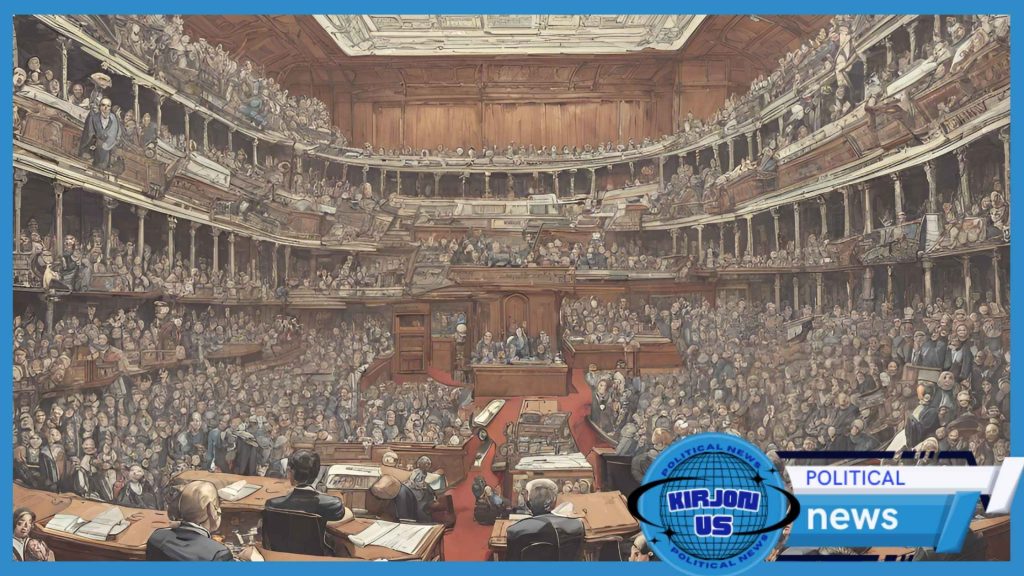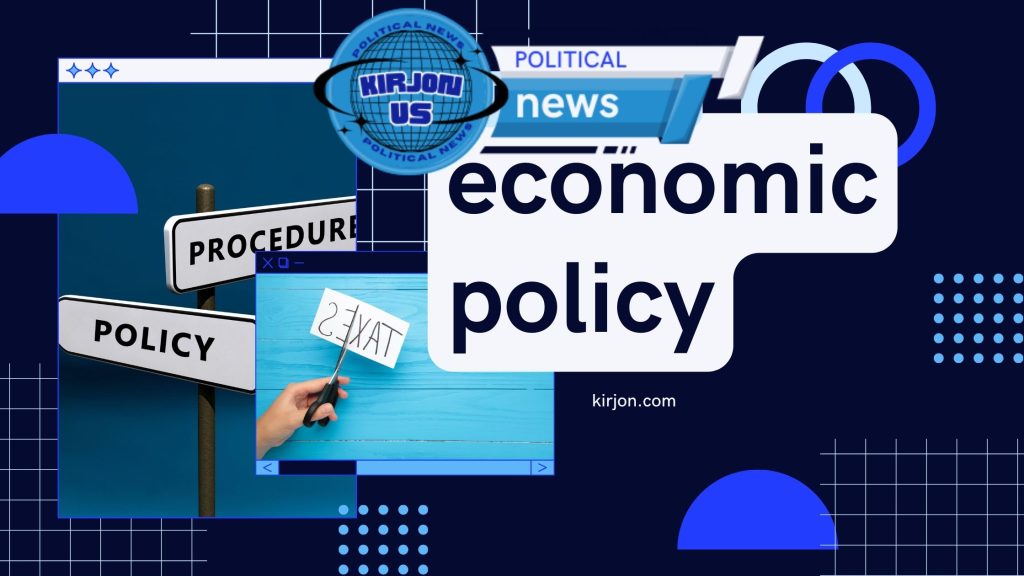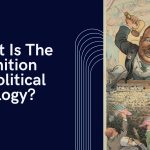In the realm of economics, policies play a pivotal role in shaping the trajectory of nations’ economic growth, stability, and welfare. Among these policies, the new economic policy stands out as a significant framework adopted by various governments worldwide. Understanding the essence of this policy is paramount for grasping the intricacies of modern economic governance.
Prior to delving deeper, it’s essential to recognize that economic policies aren’t static; they evolve in response to changing socio-political landscapes, global economic trends, and the exigencies of the times. The emergence of the new economic policy marks a pivotal shift in economic thinking and governance, reflecting a departure from traditional approaches to addressing economic challenges.
In this article, we’ll embark on an insightful journey into comprehending the essence, objectives, implementation strategies, and socio-economic ramifications of the new economic policy. By unraveling its layers, we aim to elucidate its significance in shaping contemporary economic paradigms and fostering sustainable growth and development. So, let’s dive into the intricacies of the new economic policy and unravel its implications for economies worldwide.
Historical Context

Pre-New Economic Policy Era
Before the advent of the new economic policy, many nations adhered to conventional economic models characterized by extensive government intervention, protectionist measures, and centralized planning. These models, often associated with socialism or state capitalism, aimed to achieve economic equity and social welfare through state control of key industries, distribution of resources, and regulation of markets.
Factors Leading to the Need for a New Economic Policy
However, as the global economic landscape evolved, several factors emerged that necessitated a reevaluation of existing economic paradigms. Rapid globalization, technological advancements, and shifts in consumer preferences fueled a growing recognition of the limitations of traditional economic models. Moreover, stagnating growth rates, inefficiencies in resource allocation, and burgeoning fiscal deficits underscored the need for reform.
In response to these challenges, policymakers began exploring alternative approaches to economic governance that emphasized market mechanisms, deregulation, and privatization. This quest for innovation and adaptation laid the groundwork for the formulation and adoption of the new economic policy, heralding a new era in economic thought and practice.
Definition and Objectives

Defining the New Economic Policy
The new economic policy represents a paradigmatic shift in economic governance, characterized by a departure from traditional command-and-control models towards market-oriented principles. It entails a comprehensive framework of policy measures aimed at liberalizing economies, enhancing efficiency, and fostering sustainable growth.
Objectives Aimed to be Achieved through the New Economic Policy
- Economic Growth: One of the primary objectives of the new economic policy is to stimulate economic growth by leveraging market forces to drive productivity, innovation, and investment.
- Efficiency and Competitiveness: By promoting competition, streamlining regulations, and incentivizing entrepreneurship, the policy seeks to enhance the efficiency and competitiveness of industries and markets.
- Private Sector Development: Emphasizing the role of the private sector as an engine of growth, the policy aims to facilitate its expansion through deregulation, privatization, and investment-friendly policies.
- Employment Generation: Creating employment opportunities is a key goal of the new economic policy, as it seeks to harness the dynamism of market-driven growth to absorb surplus labor and reduce unemployment.
- Poverty Alleviation: While fostering economic growth, the policy endeavors to address poverty by promoting inclusive development, social safety nets, and targeted interventions to uplift marginalized communities.
- Fiscal Sustainability: Ensuring fiscal discipline and sustainability is integral to the new economic policy, as it strives to balance the pursuit of growth with prudent fiscal management and debt sustainability.
- Global Integration: Embracing globalization and international trade is another objective of the policy, as it seeks to leverage global markets, attract foreign investment, and enhance economic resilience through greater integration.
- Environmental Sustainability: Recognizing the imperative of sustainable development, the policy aims to reconcile economic growth with environmental preservation through green initiatives, eco-friendly practices, and sustainable resource management.
By pursuing these objectives, the new economic policy aspires to chart a course towards robust, inclusive, and sustainable economic development, aligning national aspirations with global imperatives in an interconnected world.
Key Components

Main Features and Components of the New Economic Policy
The new economic policy encompasses a range of interconnected measures and initiatives designed to reshape economic structures, incentivize investment, and foster competitiveness. Let’s explore some of its key components:
1. Deregulation and Market Liberalization
Deregulation entails the removal or relaxation of government regulations and controls that impede market efficiency and inhibit private sector dynamism. By reducing bureaucratic hurdles, simplifying licensing procedures, and promoting free competition, deregulation aims to spur innovation, investment, and entrepreneurship.
2. Privatization of State-Owned Enterprises
Privatization involves the transfer of ownership and management control of state-owned enterprises (SOEs) to the private sector. This strategic divestiture aims to improve efficiency, enhance productivity, and inject competition into previously monopolized sectors. Privatization also serves to unlock the latent potential of underperforming assets and stimulate private investment.
3. Fiscal Reforms and Taxation Policies
Fiscal reforms encompass a spectrum of measures aimed at rationalizing tax structures, broadening the tax base, and enhancing revenue mobilization while ensuring fairness and equity. By simplifying tax codes, reducing tax rates, and combating tax evasion, these policies seek to incentivize compliance, promote investment, and stimulate economic activity.
4. Trade Liberalization and Global Integration
Trade liberalization involves the reduction or elimination of trade barriers such as tariffs, quotas, and import restrictions to facilitate the free flow of goods and services across borders. Embracing globalization, the new economic policy seeks to integrate domestic economies into the global marketplace, attract foreign investment, and capitalize on comparative advantages to enhance competitiveness and foster economic diversification.
5. Financial Sector Reforms
Financial sector reforms aim to modernize and strengthen banking and financial systems, promote capital market development, and enhance access to finance for businesses and individuals. Measures may include liberalization of interest rates, deregulation of capital flows, strengthening of regulatory frameworks, and promotion of financial inclusion initiatives to broaden access to banking services and credit.
6. Infrastructure Development
Investment in infrastructure is vital for laying the foundation for sustainable economic growth and development. The new economic policy prioritizes infrastructure development through strategic investments in transportation, energy, telecommunications, and other critical sectors to enhance connectivity, reduce logistical bottlenecks, and improve productivity.
7. Social Safety Nets and Human Capital Development
While promoting market-driven growth, the new economic policy recognizes the importance of social protection and human capital development. Initiatives may include the establishment of social safety nets, investment in education and healthcare, and skills development programs to ensure that the benefits of economic growth are shared equitably and sustainably.
By addressing these key components comprehensively, the new economic policy endeavors to unleash the full potential of economies, stimulate innovation and productivity, and create a conducive environment for sustainable and inclusive development.
Implementation

Process of Implementing the New Economic Policy
Implementing the new economic policy entails a multifaceted and iterative process that involves coordination among various stakeholders, including government agencies, private sector entities, civil society organizations, and international partners. The following steps are typically involved in the implementation phase:
1. Policy Formulation and Planning
The implementation process begins with the formulation of a coherent policy framework that outlines the objectives, strategies, and action plans for reform. This involves conducting thorough analyses of economic conditions, identifying key challenges and opportunities, and consulting stakeholders to garner input and consensus.
2. Legislative and Institutional Reforms
Effective implementation often requires legislative and institutional reforms to create an enabling legal and regulatory environment. Governments may enact new laws, amend existing regulations, and establish specialized agencies or task forces to oversee the implementation process and ensure compliance.
3. Capacity Building and Training
Building the requisite capacity and expertise among government officials, policymakers, and relevant stakeholders is essential for successful implementation. Training programs, workshops, and technical assistance initiatives may be organized to enhance skills, knowledge, and understanding of the new economic policy and its implications.
4. Stakeholder Engagement and Consultation
Engaging stakeholders, including businesses, civil society groups, labor unions, and marginalized communities, is crucial for garnering support, addressing concerns, and fostering ownership of the reform process. Consultative mechanisms such as public hearings, roundtable discussions, and feedback mechanisms facilitate dialogue and consensus-building.
5. Pilot Projects and Demonstrations
Piloting initiatives and demonstration projects allow policymakers to test the feasibility and effectiveness of policy interventions on a smaller scale before scaling up implementation. These pilot projects provide valuable insights, identify challenges, and inform adjustments to the policy design and implementation strategy.
6. Monitoring and Evaluation
Monitoring progress and evaluating the impact of the new economic policy are integral to ensuring accountability, identifying bottlenecks, and refining strategies over time. Key performance indicators (KPIs) are established to track progress towards objectives, and regular assessments are conducted to measure outcomes and identify areas for improvement.
7. Adaptation and Flexibility
Flexibility and adaptability are essential qualities of successful implementation, given the dynamic nature of economic conditions and policy environments. Policymakers must remain responsive to changing circumstances, feedback from stakeholders, and lessons learned from implementation experiences, adjusting strategies as needed to achieve desired outcomes.
By following these steps and principles, governments can navigate the complexities of implementation and maximize the effectiveness of the new economic policy in achieving its objectives of promoting sustainable growth, enhancing competitiveness, and improving the well-being of citizens.
Impact on Economy

The implementation of the new economic policy can have profound effects on various facets of the economy, reshaping its structure, performance, and prospects. Let’s delve into the positive impacts, as well as the criticisms and drawbacks associated with the new economic policy:
Positive Impacts
- Economic Growth and Productivity: By promoting market-oriented reforms, deregulation, and privatization, the new economic policy can stimulate economic growth and enhance productivity levels. Increased competition and efficiency improvements can lead to higher output and GDP growth rates.
- Foreign Direct Investment (FDI) Inflows: Trade liberalization and globalization initiatives under the new economic policy can attract foreign investors seeking access to new markets and investment opportunities. FDI inflows can contribute to capital formation, technology transfer, and job creation.
- Job Creation and Employment Opportunities: The expansion of the private sector and investment-driven growth can generate employment opportunities across various sectors of the economy. Entrepreneurial ventures, small and medium-sized enterprises (SMEs), and export-oriented industries may particularly benefit from job creation.
- Enhanced Competitiveness and Innovation: Market-oriented reforms and competition-driven dynamics can foster innovation, entrepreneurship, and technological advancement. Increased competition can incentivize firms to invest in research and development (R&D), adopt best practices, and improve product quality and efficiency.
- Efficient Allocation of Resources: Deregulation and privatization initiatives can lead to a more efficient allocation of resources, as market forces determine resource allocation based on demand and supply dynamics. This can result in optimal utilization of factors of production and enhanced resource efficiency.
Criticisms and Drawbacks
- Income Inequality and Social Disparities: Critics argue that market-oriented reforms may exacerbate income inequality and widen social disparities, as benefits may disproportionately accrue to wealthier segments of society. Ensuring inclusivity and addressing the needs of marginalized groups becomes crucial to mitigate social tensions.
- Risk of Market Failures and Monopolies: Unregulated markets may be susceptible to market failures, such as monopolistic practices, price gouging, and environmental externalities. Effective regulatory frameworks and competition policies are necessary to prevent market distortions and ensure fair competition.
- Vulnerability to External Shocks: Increased integration into global markets exposes economies to external shocks, such as financial crises, commodity price fluctuations, and geopolitical uncertainties. Strengthening resilience through prudent macroeconomic management and diversification strategies is essential to mitigate vulnerabilities.
- Environmental Degradation: Rapid economic growth driven by industrialization and resource exploitation can exacerbate environmental degradation and ecological imbalances. Balancing economic development with environmental sustainability requires proactive measures, such as green technologies, pollution control, and conservation efforts.
- Social Safety Nets and Welfare Provision: Market-oriented reforms may undermine social safety nets and welfare provisions traditionally provided by the state, leading to concerns about social protection, healthcare access, and education affordability. Ensuring equitable access to essential services remains a key challenge for policymakers.
In conclusion, while the new economic policy can unlock growth potentials and enhance economic dynamism, it also poses challenges and risks that necessitate careful management and policy responses. Striking a balance between market efficiency and social equity is imperative to ensure that the benefits of economic growth are shared equitably and sustainably across society.
Global Perspective
The new economic policy does not operate in isolation; rather, it is part of a broader global economic landscape shaped by interconnectedness, interdependence, and cross-border flows of goods, services, capital, and information. Understanding the global perspective of the new economic policy entails examining its implications within the context of international trade, investment, and economic cooperation:
Comparison with Economic Policies in Other Countries
- Liberalization Trends: Many countries around the world have embraced similar market-oriented reforms and liberalization measures in response to globalization and competitive pressures. Examples include China’s transition towards a socialist market economy, India’s economic liberalization in the early 1990s, and Eastern European countries’ shift towards market-based systems after the collapse of communism.
- Regional Integration Initiatives: Regional economic blocs and integration initiatives, such as the European Union (EU), Association of Southeast Asian Nations (ASEAN), and Mercosur, have also influenced economic policies and governance frameworks. These initiatives aim to foster economic cooperation, facilitate trade and investment flows, and enhance regional competitiveness.
Influence of the New Economic Policy on Global Economic Trends
- Trade and Investment Flows: The new economic policy’s emphasis on trade liberalization and attracting foreign investment can contribute to increased trade and investment flows between countries. Global supply chains, multinational corporations, and cross-border investment networks play a pivotal role in shaping global economic trends and patterns of production and consumption.
- Technological Innovation and Digitalization: The new economic policy’s focus on innovation, entrepreneurship, and technology-driven growth aligns with broader global trends towards digitalization, automation, and the knowledge economy. Advancements in information technology, artificial intelligence, and biotechnology are reshaping industries and transforming business models on a global scale.
Challenges and Opportunities in a Globalized World
- Competitive Pressures: Globalization exposes economies to intensified competition from foreign producers, leading to concerns about job displacement, wage stagnation, and deindustrialization in certain sectors. Adaptation to technological change and upgrading of skills become imperative to remain competitive in a globalized marketplace.
- Policy Coordination and Cooperation: Addressing transnational challenges, such as climate change, financial stability, and pandemics, requires enhanced policy coordination and international cooperation. Multilateral institutions, such as the International Monetary Fund (IMF), World Bank, and World Trade Organization (WTO), play a crucial role in facilitating dialogue, cooperation, and collective action among nations.
Future Directions and Outlook
- Sustainable Development Goals (SDGs): The new economic policy’s alignment with the United Nations’ SDGs underscores its commitment to achieving sustainable, inclusive, and resilient development outcomes. Integration of environmental, social, and governance (ESG) considerations into economic policies is essential to address global challenges and foster sustainable development.
- Resilience and Adaptability: Building resilience and adaptability to navigate uncertain global environments, such as geopolitical tensions, trade disputes, and health crises, remains a priority for policymakers. Flexibility in policy responses, diversification of economic structures, and investment in human capital and innovation are key strategies for enhancing resilience.
In essence, the global perspective of the new economic policy highlights its interconnectedness with broader global trends and dynamics, underscoring the importance of collaboration, dialogue, and collective action to address shared challenges and capitalize on emerging opportunities in a rapidly evolving world.
Role of Government
The government plays a pivotal role in shaping and implementing economic policies, including the new economic policy. Its functions encompass policy formulation, regulation, coordination, and facilitation of economic activities. Let’s explore the various facets of the government’s role in economic governance:
Setting Policy Objectives and Priorities
- Defining Economic Goals: The government articulates the overarching economic objectives and priorities that guide policymaking, such as promoting growth, stability, employment, and equity. These goals serve as a compass for formulating strategies and interventions under the new economic policy.
- Addressing Market Failures: Governments intervene to address market failures, such as externalities, information asymmetries, and public goods provision. Policies may include regulations, subsidies, taxes, and public investments to correct distortions and enhance market efficiency.
Policy Formulation and Implementation
- Designing Economic Policies: The government, often through specialized ministries or agencies, formulates detailed policy measures and initiatives to achieve its economic objectives. This involves conducting research, analyzing data, consulting stakeholders, and assessing the potential impacts of policy interventions.
- Legislative and Regulatory Frameworks: Governments enact laws, regulations, and administrative measures to create an enabling environment for economic activities. This includes establishing rules governing property rights, contracts, competition, labor relations, environmental protection, and consumer safety.
Providing Public Goods and Services
- Infrastructure Development: Governments invest in infrastructure, such as transportation, energy, communication, and utilities, to facilitate economic activities and enhance productivity. Infrastructure development is vital for enabling trade, attracting investments, and fostering regional connectivity.
- Social Safety Nets: Governments implement social welfare programs, such as unemployment benefits, healthcare services, education subsidies, and poverty alleviation initiatives, to mitigate social risks and promote inclusive development. These programs aim to ensure basic standards of living and social cohesion.
Facilitating Market Operations
- Market Regulation and Oversight: Governments regulate markets to ensure fair competition, consumer protection, financial stability, and environmental sustainability. Regulatory bodies oversee sectors such as banking, securities, telecommunications, and utilities to safeguard public interests and maintain market integrity.
- Promoting Competition and Innovation: Governments foster competition and innovation by removing barriers to entry, enforcing antitrust laws, and supporting research and development activities. Competition policy aims to prevent monopolistic practices, encourage entrepreneurship, and enhance market dynamism.
Economic Stabilization and Crisis Management
- Monetary and Fiscal Policies: Governments use monetary policy tools, such as interest rates and money supply, and fiscal policy measures, such as taxation and spending, to stabilize the economy, control inflation, and manage business cycles. Central banks and finance ministries play key roles in macroeconomic management.
- Crisis Response and Recovery: Governments intervene during economic crises, such as recessions, financial meltdowns, or natural disasters, to provide stimulus measures, bailout troubled institutions, and restore confidence. Crisis management strategies aim to minimize disruptions and facilitate economic recovery.
In conclusion, the government’s role in economic governance is multifaceted and multifunctional, encompassing policy formulation, regulation, provision of public goods, facilitation of market operations, and economic stabilization. Effective government intervention is essential for promoting sustainable and inclusive economic development, balancing market dynamics, and addressing societal needs and aspirations. The government’s role evolves in response to changing economic conditions, technological advancements, and societal expectations, requiring adaptive and forward-looking policymaking to navigate complex challenges and opportunities in a dynamic global environment.
Socio-Economic Implications
The implementation of the new economic policy has far-reaching implications for various segments of society, shaping patterns of economic activity, income distribution, and social welfare. Let’s explore the socio-economic implications of the new economic policy:
Effects on Different Sections of Society
- Businesses and Entrepreneurs: Market-oriented reforms and deregulation under the new economic policy create opportunities for businesses and entrepreneurs to innovate, invest, and expand operations. Small and medium-sized enterprises (SMEs) benefit from improved access to markets, finance, and technology, fostering entrepreneurship and job creation.
- Workers and Labor Force: While market-driven growth can create employment opportunities and higher wages in certain sectors, it may also lead to job displacement, wage inequality, and precarious employment conditions for vulnerable workers. Skill upgrading, retraining programs, and social protection measures are necessary to mitigate adverse effects on workers.
- Consumers and Household Welfare: Increased competition and market liberalization can enhance consumer choice, lower prices, and improve product quality and variety. However, rising living costs, particularly in essential goods and services, may strain household budgets, necessitating targeted social assistance and affordability measures.
Addressing Socio-Economic Disparities
- Income Inequality: The new economic policy may exacerbate income inequality by disproportionately benefiting wealthier individuals and corporations. Progressive taxation, social transfers, and inclusive growth strategies are essential to redistribute wealth and reduce disparities in income and wealth ownership.
- Regional Disparities: Economic reforms may unevenly impact different regions, exacerbating disparities between urban and rural areas, and among regions with varying levels of development. Targeted investments in infrastructure, education, healthcare, and local economic development initiatives can bridge regional divides and promote balanced growth.
Promoting Inclusive Development
- Social Safety Nets: Strengthening social safety nets and welfare provisions is essential to protect vulnerable groups, such as the unemployed, elderly, and marginalized communities, from the adverse effects of economic restructuring. Universal healthcare, education subsidies, and targeted cash transfer programs enhance social resilience and reduce poverty.
- Education and Skills Development: Investing in education, vocational training, and lifelong learning opportunities equips individuals with the skills and capabilities needed to thrive in a dynamic and competitive economy. Education reforms that emphasize STEM (science, technology, engineering, and mathematics) subjects, digital literacy, and soft skills are crucial for enhancing employability and upward mobility.
Empowering Marginalized Communities
- Gender Equality: Gender-responsive policies and empowerment initiatives are essential for advancing women’s economic participation, closing the gender pay gap, and promoting women’s entrepreneurship and leadership. Access to affordable childcare, parental leave, and legal protection against discrimination are key enablers of gender equality in the workforce.
- Ethnic and Minority Groups: Inclusive development policies should address the socio-economic needs and aspirations of ethnic minorities, indigenous peoples, and marginalized communities. Affirmative action programs, land rights recognition, and cultural preservation efforts promote social cohesion and empower historically marginalized groups.
In conclusion, the socio-economic implications of the new economic policy are multifaceted, influencing various dimensions of society, including income distribution, regional development, social cohesion, and intergenerational mobility. While market-oriented reforms hold the potential to stimulate economic growth and innovation, they also pose challenges in terms of income inequality, job insecurity, and social exclusion. A holistic approach to socio-economic development is imperative, one that combines market dynamism with social protection, inclusive institutions, and targeted interventions to ensure that the benefits of economic growth are equitably shared and sustainable over the long term.
Case Studies
Successful Implementation of Market-Oriented Reforms
1. China’s Economic Transformation
Background: China’s economic reform and opening-up policy, initiated in the late 1970s under the leadership of Deng Xiaoping, marked a significant departure from centrally planned socialism towards a market-oriented economy.
Key Components: The reform measures included liberalization of prices, privatization of state-owned enterprises, encouragement of foreign investment, and integration into the global economy through trade and investment liberalization.
Impact: China’s transformation into the world’s second-largest economy and a global manufacturing powerhouse is a testament to the success of market-oriented reforms. The reforms have fueled rapid economic growth, poverty reduction, and technological advancement, lifting millions of people out of poverty and propelling China onto the world stage.
2. India’s Economic Liberalization
Background: In the early 1990s, India embarked on a path of economic liberalization and deregulation in response to a severe balance of payments crisis. The reforms aimed to dismantle the License Raj system, promote private sector investment, and integrate the Indian economy into the global marketplace.
Key Components: The liberalization measures included trade and investment liberalization, privatization of state-owned enterprises, financial sector reforms, and fiscal consolidation efforts to restore macroeconomic stability.
Impact: India’s economic liberalization has led to a surge in economic growth, foreign investment inflows, and expansion of the services sector. The reforms have contributed to poverty reduction, urbanization, and the emergence of a vibrant entrepreneurial ecosystem, albeit with persistent challenges such as income inequality and social disparities.
Lessons Learned and Best Practices
1. Policy Consistency and Long-Term Vision
Both China and India demonstrate the importance of maintaining policy consistency and long-term vision in implementing market-oriented reforms. Clear objectives, gradual phasing of reforms, and adaptability to changing circumstances are essential for sustaining momentum and overcoming implementation challenges.
2. Inclusive Development Strategies
Ensuring that market-oriented reforms benefit all segments of society requires proactive measures to address income inequality, regional disparities, and social exclusion. Targeted interventions, social safety nets, and investments in human capital are critical for promoting inclusive development and reducing poverty.
The case studies of China and India underscore the transformative potential of market-oriented reforms in driving economic growth, poverty reduction, and global integration. By drawing lessons from their experiences, policymakers can design and implement effective strategies to harness the benefits of market dynamism while safeguarding social equity and sustainability. Case studies serve as valuable benchmarks and learning opportunities for countries embarking on similar paths of economic reform and development.
Conclusion
The new economic policy represents a paradigm shift towards market-oriented principles, aimed at fostering economic growth, efficiency, and competitiveness. Through deregulation, privatization, trade liberalization, and fiscal reforms, governments seek to unleash the full potential of their economies and create opportunities for businesses, entrepreneurs, and workers.
While the new economic policy holds the promise of prosperity and innovation, it also presents challenges and risks, including income inequality, social disparities, and environmental degradation. Addressing these challenges requires a balanced approach that combines market dynamism with social protection, inclusivity, and sustainability.
By learning from case studies, best practices, and global perspectives, policymakers can navigate the complexities of economic governance and steer their countries towards sustainable and inclusive development. The new economic policy is not a one-size-fits-all solution, but rather a framework for adaptation, innovation, and continuous improvement in response to changing economic realities.
As nations embark on their journeys of economic reform and transformation, it is essential to prioritize the well-being of all citizens, promote social justice, and ensure that the benefits of economic growth are equitably shared across society. With prudent policymaking, effective governance, and collaborative efforts, countries can realize the full potential of the new economic policy and build a brighter future for generations to come.
FAQs (Frequently Asked Questions)
What are the main objectives of the new economic policy?
The main objectives of the new economic policy include promoting economic growth, enhancing efficiency and competitiveness, stimulating private sector development, generating employment opportunities, alleviating poverty, ensuring fiscal sustainability, integrating into the global economy, and promoting environmental sustainability.
How does the new economic policy differ from previous economic models?
The new economic policy differs from previous economic models by emphasizing market-oriented principles, deregulation, privatization, and trade liberalization. It represents a departure from command-and-control approaches towards a more flexible, adaptive, and market-driven approach to economic governance.
What are some examples of successful implementation of the new economic policy?
Examples of successful implementation of the new economic policy include China’s economic transformation and India’s economic liberalization. Both countries have experienced rapid economic growth, poverty reduction, and integration into the global economy through market-oriented reforms.
How does the new economic policy address social disparities and inclusivity?
The new economic policy addresses social disparities and inclusivity through targeted interventions, social safety nets, and investments in human capital. Measures such as progressive taxation, social welfare programs, education and healthcare subsidies, and affirmative action initiatives aim to promote inclusive development and reduce poverty.
What are the key challenges associated with the new economic policy?
Key challenges associated with the new economic policy include income inequality, regional disparities, environmental degradation, market failures, and vulnerability to external shocks. Policymakers must address these challenges through effective governance, policy coordination, and social protection measures to ensure sustainable and inclusive development.







